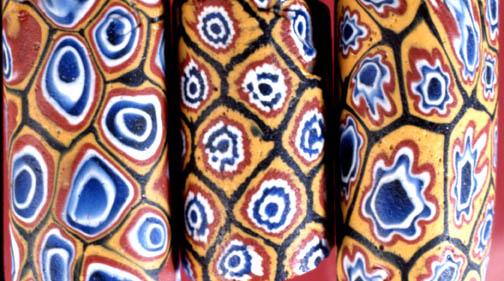|
This is a photograph that I often use to help people understand the similarities and differences between the three primary types of Venetian mosaic canes.
All three have what approximates to being the "same" pattern (in many respects), and have the exact same color scheme. Their color sequence is: blue, white, blue, white, red, yellow, and blue. The outer blue looks black because the hue is saturated and has nothing to bounce off of to appear more clearly blue (as it would if it were next to a white layer). These are specimens 7, 17, and 49 from the Chart I showed earlier.
The left bead is decorated with Layered canes, depicting concentric rows of colors, and because of the dark center is easily seen as an "eye" cane. The middle bead also has concentric layers of the same colors, but has been made by compositing tiny canes or rods together. In comparison to the left cane, the lines between colors are bumpy, and it's possible to see individual units. Note also that a mistake was made, and a few rods are out of alignment. In the right bead, the pattern is a molded flower. If you compare the left and right beads, you may notice that they are much more alike than different structurally, and more like each other than like the composite cane. The molded cane had been inserted into a flower-shaped mold one time, after the red layer was added. This molding changed the round conformations of the red layer and those below it into petal shapes. Then, the original cane was layered with yellow and then blue glass for the design to be completed.
It's not difficult to find groups of beads that allow this sort of comparison because of similarity of patterns. I have found many, and I'll show others. We should not be surprised that molded and layered canes can be very alike, since it is the molding of certain layers that distinguishes them from one another. In your mind, add the molding to one or subtract it from the other, and you have the same cane. It's more surprising that composite canes copy layered and molded canes, since the latter are easier to make, and it seems as though making these patterns via compositing would be a waste of time. Nevertheless, though the composite technique is more demanding and much more variable, copies of canes of other types are frequent. In this series, I will tend to show unsual or rare beads, since I think more people will find these interesting. But I'll try to make a good foundation for these beads too.
|
|

